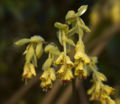| Corylopsis | |
|---|---|
 | |
| Corylopsis spicata in flower | |
| Scientific classification | |
| Kingdom: | Plantae |
| Clade: | Tracheophytes |
| Clade: | Angiosperms |
| Clade: | Eudicots |
| Order: | Saxifragales |
| Family: | Hamamelidaceae |
| Subfamily: | Hamameloideae |
| Tribe: | Corylopsideae Harms |
| Genus: | Corylopsis Siebold & Zucc. |
Corylopsis is a genus of 25 species [1] of shrubs in the witch hazel family, Hamamelidaceae, native to eastern Asia with the majority of species endemic to China but with some also in Japan, Korea, and the Himalayas. This genus is also known from the extinct species Corylopsis reedae described from Eocene leaf fossils found in Washington State, USA.
Contents
They grow to 2–6 m (6 ft 7 in – 19 ft 8 in) tall, often with a crown wider than the shrub's height. The leaves are ovate with an acute apex and a serrated margin, 4–20 cm (2–8 in) long and 3–15 cm (1.2–5.9 in) broad. The flowers are produced in late winter in pendulous racemes 3–9 cm (1.2–3.5 in) long with 5-30 flowers; each flower has five pale yellow petals, 4–9 mm long. The fruit is a dry capsule 10–12 mm long, containing two glossy black seeds.


